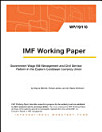Explaining High Unemployment in ECCU Countries
ก.ค. 2019 · International Monetary Fund
eBook
32
หน้า
reportคะแนนและรีวิวไม่ได้รับการตรวจสอบยืนยัน ดูข้อมูลเพิ่มเติม
เกี่ยวกับ eBook เล่มนี้
In recent years, unemployment rates in some ECCU countries have been among the highest globally. This paper evaluates several factors that could explain them, finding that high unit labor costs, in a context of strong unionization, are significantly associated with high structural unemployment, while the global crisis added a cyclical component. Our analysis also suggests that high-paid jobs in the public and tourism sectors, which have been growing considerably in recent decades, could have increased the reservation wage and lowered labor force participation. We find no indication that high structural unemployment is related to the phase out of EU preferences on bananas/sugar exports or to a skills mismatch. As expected, unemployment has been substantially, but only temporarily fueled by large natural disasters.
ให้คะแนน eBook นี้
แสดงความเห็นของคุณให้เรารับรู้
ข้อมูลในการอ่าน
สมาร์ทโฟนและแท็บเล็ต
ติดตั้งแอป Google Play Books สำหรับ Android และ iPad/iPhone แอปจะซิงค์โดยอัตโนมัติกับบัญชีของคุณ และช่วยให้คุณอ่านแบบออนไลน์หรือออฟไลน์ได้ทุกที่
แล็ปท็อปและคอมพิวเตอร์
คุณฟังหนังสือเสียงที่ซื้อจาก Google Play โดยใช้เว็บเบราว์เซอร์ในคอมพิวเตอร์ได้
eReader และอุปกรณ์อื่นๆ
หากต้องการอ่านบนอุปกรณ์ e-ink เช่น Kobo eReader คุณจะต้องดาวน์โหลดและโอนไฟล์ไปยังอุปกรณ์ของคุณ โปรดทำตามวิธีการอย่างละเอียดในศูนย์ช่วยเหลือเพื่อโอนไฟล์ไปยัง eReader ที่รองรับ




